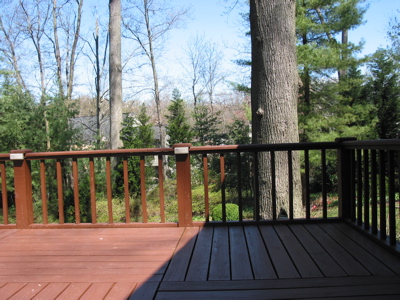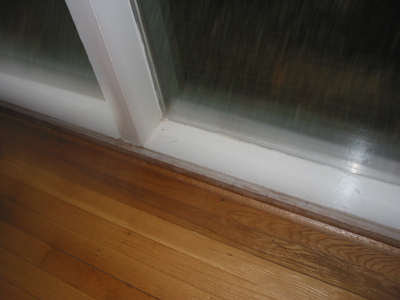
Location: 01 General : 1 Graphic Symbols
Very similar to SectElevDetail Marker JAM9, with the improved autotext handling discussed here.
Same as with Detail Area JAM9, paste just the gibberish part of the autotext from PlotMaker into the "Paste Autotext Here" field. The drawing name and number will fill in. If you are using the Double Section symbol type, paste the data from the other drawing into the "Paste Autotext 2 Here" field. If the drawings are on the same sheet, as they usually will be for a pair of sections, leave "Same Sheet Number" on. If you turn this off, the second sheet number will be generated from the second pasted text.
Once I put up that screenshot of the detail marker, I noticed that the gibberish components of the two autotexts are the same. The difference lies in the DRAWINGNUMBER_R and LAYOUTNUMBER_R tags at the front.
This means I can have reference markers (section and detail flags) that just need to be told the gibberish segment once, and can build the autotexts themselves. For these objects, instead of copying the entire autotext in PlotMaker, just copy the data within the second pair of angle brackets: "<9BEA5D4E-8700-11D8-8AA9-000A95A7B33A>".
I have added this ability to Detail Area JAM9. In the settings, paste the gibberish into the "Paste Autotext Here" field. In the drawing and layout number fields above, you will see the completed autotext fill in. You can still put non-auto text in these fields; if you delete the "Pasted" data, the fields will empty and unlock, and you can use them however you want.
For labeling doors and windows in section/elevation. This is completely different from the dimension marker used in plan.
It is intended to be used as an associated label.
How about a quick review of associated labels. To place an associated label, select the element, in the window you want the label, and Check 'label Elements' in the Info Box. Which label will be placed? Ah. Each tool has default label settings, which are configured in the Label settings dialog. For each tool you want to label, highlight it in the list at the top and choose the appropriate label from the top right flyout. This is also where you set the pen, layer, and other attributes of the label. Remember that labels can have a different layer than the elements they reference, and they usually will.
For doors and windows, starting today, set the label tool to use Door-Window Label JM9.
It draws a hexagon for windows and an ellipse for doors. It knows the difference! If Auto Size is on, the window tag will be 5/16" and the door tag will be 3/8". If these don't meet you needs, turn Auto Size off.
Once the label is placed, move it where you want it. (A method to control where labels pop up remains elusive.) Place the label on a sash with no divisions, or to the side of the window/door. Try not to obscure the design of the window/door.
See also:
Labels
Usually means a bad callTyp. Check detLev and mldgRot.
It gives me an opportunity to discuss alternate handling, or at least to give you one case study. Vassos, although it’s under construction, has occasional lapses into design development. The clients were interested in seeing alternatives for one part of an elevation. We offered two, which forked into three.
I saved a copy of the project for each alternate, with a descriptive name, in that Alternates folder. I developed the model for each alternate. We wanted to present a perspective and an elevation for each choice. Since the alternates are in separate files, and all the alternates are separate from the main PLN, it’s easy to simply use the views you already have. You can’t mess anything up.
To present the choices, I created a new subset in the main layout book. There’s no reason to create separate ‘books for each. Within the new folder, there are two layouts for each alternate. I hooked the new layouts to the 11×17 Master. Then I imported the perspective and elevation views from each PLN.
For Interactive Schedule. This you can use because it's based on the Room Name Zstamp JAM9 zone stamp. All the info listed is contained in the zone stamp; that is, it can't read the floor finish from a fill or slab.
Rm#: 0.7
Room Name: 2.0
Floor Fin: 1.5
Ceiling Fin: 1.3
Base: 0.8
Crown: 0.8
Casing: 0.8
Note: 2.5
Header Text Height: 5.0
Value Text Height: 4.0
Row Height: 0.4
For Interactive Schedule. Actually, the windows this goes with aren't even officially available*, so you can ignore this. The text height and row height are good, though.
ID: 0.5
Qty: 0.4
Units: 0.8
Type: 2.5
Manuf: 0.9
Model: 1.5
Lites: 1.2
Hinge: 0.9
TG: 0.4
RO Width: 1.2
RO Height: 1.2
Mull: 0.7
Ext Casing: 1.2
Transom Height: 1.2
Transom Lites: 1.2
Location: 1.8
Note: 2.5
Header Text Height: 5.0
Value Text Height: 4.0
Row Height: 0.4
*I have no idea.
If it hasn't already, your Software Update will soon offer you to update to OS X 10.3.9. You can go ahead and do this.
The only possible glitch I have heard of is Java apps misbehaving in Safari, or Safari failing to launch. If you observe any weirdness in Safari, re-install the "2005-002" security update. It is available at 3 Resources : Mac OS Files : SecUpd2005-002Pan.pkg. Apple has a page on the issue.
Incidentally, this is likely the last update to Panther before OS X 10.4 ("Tiger") is released at the end of the month. That is a major update and we will handle it as wait-and-see.
Obsolete. Referencing in AC10 and later doesn't work this way.
It sure is nice the way detail markers know where their drawings are placed. It sure would be nicer if we could as easily refer to any placed drawing. If you could place dynamic drawing and sheet references in section marker objects, and call out enlarged plans, and write notes of the form, "Do this like this, see detail A3-5/12." And since you can't place details in detail windows, use an object detail marker there.
Well, you can refer to any placed drawing. But I wouldn't call it easy. In fact, I think this is the most annoying worthwhile thing in all of ArchICAD.
Here's how. We'll do the drawing number first.
Import the drawing to a layout.
Right click on the drawing (in the layout or in the tree) and choose "Set as Autotext Reference".
Activate the text tool. Start a text block by double-clicking. In the text editing area (at the cursor), right-click and choose "Insert Autotext for [DrawingName]" -> Drawing Number. This results in a blob of gibberish like "< DRAWINGNUMBER_R ><9BEA5D4E-8700-11D8-8AA9-000A95A7B33A>". Copy this. Tip: Cmd+A works to select all while editing text. So, Cmd+A, Cmd+C.
Return to ArchiCAD. Open whatever it is that needs the reference, e.g., a detail marker object or a text block. Paste into the appropriate field or location.
Of course, you usually need the layout number too. Return to PlotMaker. You should see the open text block as you left it. Delete the DRAWINGNUMBER stuff. Repeat the process, this time choosing "Layout Number". Cmd+A, Cmd+C, Back to ArchiCAD, Paste.
A detail marker will look like this in ArchiCAD:

The gibberish bits resolve themselves in PlotMaker, giving the location of the drawing you set as autotext reference in the beginning.
Some typical applications for Wood Beam JAM9.
Location: 06 Wood & Plastic / Structure
An object for modeling and annotating wood structure elements.
One day, I lost the ability to move door tags by their editing hotspot. Once I went to WE and switched "Pet palette movement" to "Jump to preferred position" under User Preference schemes -> Dialog boxes and palettes, the tags worked again.
This is the same setting that caused Kay's roof handle problem. It's interesting that they're both "moving a related thingy" problems.
Since there's such a thing in our little world as a "layout", referring to guide lines as "layout" lines isn't right.

